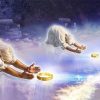Can we really take the books of Genesis and Revelation literally?
The reason for this question is that most people today, even many Christians, do not accept the plain-sense meaning of the bookends of the Bible — Genesis and Revelation. Instead, they spiritualize their interpretation, arguing that the plain-sense meaning of Scripture is not its true meaning. The result is that the beginning and ending of the Bible are the two most abused areas of God’s Word, having been spiritualized into meaninglessness. This results in a travesty to one’s understanding of God and His plan of salvation.
To combat this abuse of God’s Word, our television program Christ in Prophecy has been airing excerpts from our 2022 Epic Battles of the Bible Conference. Our hope is that you will gain an appreciation for the literal interpretation of the Bible. And, we also hope that you will gain the wonderful realization that Genesis and Revelation are not at odds, but that these books complement each other. God’s plan for the ages is meant to be understood and that is meant to provide us hope in these challenging days.
In our last three episodes, Eric Hovind of Creation Today Ministries addressed a controversial debate in Genesis: A Literal Global Flood. In our second episode, Nathan Jones addressed a controversial debate from the book of Revelation: A Literal 1000-Year Kingdom. In our third episode, Dr. Jobe Martin of Biblical Discipleship Ministries addressed A Literal 6-Day Creation.
In the fourth and final episode of our series, I will swing back to the other end of the Bible to address a controversial debate in Revelation: A Literal Rapture or Tribulation to Endure? Will Church Age Christians have to endure the horrors of the Tribulation? Let’s find out!
Evidence of the Rapture in Revelation
What’s the evidence for the Rapture in Revelation? We have the example of John being swept up into the throne room of Heaven and the absence of the Church during the events of the Tribulation.
There’s even more evidence within the book of Revelation that points to the Rapture of the Church.
Throughout the letters Jesus dictates to the Seven Churches He says, “He who has an ear to hear, let him hear what the Spirit says to the churches.” That conveys the reality that these messages are not only for the seven named churches but for all who hear the voice of our Good Shepherd. The promises to overcomers are tied to these statements as well, demonstrating that the promise that Jesus gives to the people in those seven churches represents promises given to believers throughout the Church Age.
Later, in Revelation 13:9, as the dragon and the beast from the sea are described, John advises, “If anyone has an ear, let him hear.” Missing from that recitation of the original formula is the qualifying phrase “…what the Spirit says to the churches.” In other words, John’s description of the horrors that will take place and be poured out during the Tribulation is for anyone who would heed the warning. So, in the language of Psalm 2, it is for any who would “show discernment and take warning.” What would they need to do? Well, if they take warning, they would need to “worship the LORD with reverence.” In other words, rejoicing and doing “homage to the Son… that you not perish in the way…” And as the Psalmist writes, “How blessed are all who take refuge in Him!”
Once again, John’s specific language is a clue that the Church is simply not here on the earth during the Tribulation.
Here’s another example. In Revelation 3:10, Jesus promises to deliver those who have kept the word of His perseverance. He said, “I will also keep you from the hour of testing, the hour which is about to come upon the whole world, to test those who dwell on the earth.” The word that translates “from” in my New American Standard Version of the Bible is “ek“. According to Strong’s Concordance, that Greek preposition translates “out from” and denotes “an exit or emission from,” as in a separation from something. In other words, it means “a removal from a time and a place.” Other words could have been used in this passage and would have suggested another reality. The Greek word “dia,” for example, could have been used had Jesus meant to convey an expectation that He would preserve His Church through the coming hour of testing that would take place on the whole world. And, of course, the clear text of this verse points to a coming event that will, indeed, be experienced worldwide.
So, how can we understand the very plain sense that is spoken in all these verses? The first key to understanding Revelation is to believe it. If you believe it, accepting Jesus’ testimony as true and relevant, then you will understand it. How? By reading it for its plain-sense meaning.
What do I mean by that? Well, as Dr. David Reagan says, “If the plain sense makes sense, look for no other sense, lest you end up with nonsense.”
That is why I advocate for a literal Rapture of the Church, with plain-sense evidence woven throughout the book of Revelation.
There is another key to unlocking the supposed mysteries of Revelation, and that is to interpret the Bible literally. Within its 22 chapters, 404 verses, and almost 12,000 words, Revelation weaves in more references to the Old Testament than any other book of the Bible. It contains 49 direct references to Isaiah alone, 34 direct references to Daniel, 23 direct references to the Psalms, 21 to Exodus, 16 to Jeremiah, and 10 to Zechariah. And, it also contains passages and references to Genesis, Leviticus, Numbers, Deuteronomy, Kings, Proverbs, Hosea, Joel, Malachi, Amos, Job, and Micah.
There are other inferences that can only be understood in light of Old Testament texts. For instance, when one of the elders told John to stop weeping over the fact that no one in heaven or on earth or under the earth was found worthy to open the sealed book from Revelation 5, he said this, “Behold, the Lion that is of the tribe of Judah, the Root of David, has overcome so as to open the book and its seven seals.” We often overlook the fact that those titles spring from the Old Testament, from Genesis 49 and Isaiah 11 specifically. And then, when John turned and saw “a Lamb standing as if slain,” he is calling Jesus by the title used by John the Baptist in John 1:29.
At other times, Revelation interprets its own symbols. So here again, when John turns and sees the “Lamb standing, as if slain,” John describes Him as having “seven horns and seven eyes.” Then he immediately goes on to explain that those “are the seven Spirits of God, sent out into all the earth,” referring back to the seven Spirits God mentioned in Revelation 3:1 and 4:5, and described in great detail in Isaiah 11:2.
When Jesus promises to give overcomers the morning star in Revelation 2:28, we only have to keep reading to understand that symbolic reference. He reveals later in 22:16 that He is “the root and the descendant of David, the bright morning star.” So, overcomers are those who “overcome the World by believing that Jesus is the Son of God” according to 1 John 5:5, and they will receive Jesus Himself!
The point is that as authors Brock and Bodie Thoene say, “Everything means something.” The symbols woven throughout the book of Revelation are not merely fanciful figments of John’s imagination. He did not craft an intricate allegory like Alice in Wonderland. He recorded the dictated words of Jesus. John recorded the things which he had seen, the things which were contemporary to his time, and the things which will take place at some indeterminate future date.
Those of us who interpret Scripture literally realize that the Holy Spirit led the writers to incorporate beautiful word pictures. So, Jesus is called the “Rose of Sharon” and the “Lily of the Valley,” but never because He is a flower that withers and fades because both metaphors capture His exquisite beauty and His wonderful fragrance. Entire sermons have been offered just to bring out the richness of these two poetic and prophetic symbols.
Symbols point to something — to Someone — real that transcends the merely symbolic. The symbols and metaphors in Revelation have real meaning.
Saved From God’s Wrath
This brings us to, yet again, to conclude that a literal Pre-Tribulation interpretation of the Rapture is contained in Revelation.
Anyone who denies that the Rapture will occur and that it should occur before the Tribulation has to dismiss the imminence of that coming event. They have to spiritualize the plain text of Scripture, suggesting for instance that the Rapture has already taken place in ages past or that the Church needs to endure the Tribulation and the wrath of God.
People who put their trust in the Lord Jesus Christ will certainly be saved during the Tribulation. We know that, unquestionably. But, most of them will be martyred, hunted down by the Antichrist and his minions, and killed for refusing his edicts. A few will survive the Tribulation and will go into the Millennial Kingdom as mortal beings.
But, the Bride of Christ will not be beat up by her Bridegroom just prior to the marriage feast. Her purity is assured, not because of any inherent perfection that we have individually or collectively, but because we have been washed in the blood of the Lamb, and that itself is another symbolic phrase with a deeply literal meaning. The white garments that we will wear throughout eternity are not something we bring with us or weave for ourselves from strands of good intentions and gossamer. We know that even our righteous deeds are like filthy rags. No, our beautiful, white garments will be given to us by our Beloved — by our Bridegroom Himself — Jesus Christ.
We realize that many people have absorbed a spiritualized, Amillennial view of Revelation. Like the young man I cited in my booklet, Looking Forward to the Reign of Jesus Christ, there hasn’t always been an appeal toward a Pre-Tribulation Rapture position. Many people have not come to the position of believing in Amillennialism or another timing view of the Rapture because they’ve studied the Scripture, but because Amillennialism is the default position of many churches and seminaries.
Likewise, I believe that people gravitate oftentimes toward a Mid-Tribulation or Post-Tribulation expectation of the Rapture just because they haven’t read and studied. So, without being offensive, I think such positions run counter to the entirety of God’s Word.
The idea that Christians — those who put their trust in Jesus Christ for their salvation and have been washed in the blood of the Lamb — deserve punishment for their sins, well, that idea is logical, but it is woefully unbiblical. I say logical because it does seem only fitting that we should suffer for our sin, let alone for our sinfulness. But, that is the good news of the Gospel. Jesus Christ suffered for us!
Isaiah foretold this wonderful truth when he said: “Surely our griefs He Himself bore, and our sorrows He carried. He was pierced through for our transgressions; He was crushed for our iniquities; the chastening for our well-being fell upon Him, and by His scourging we are healed.” That is the meaning of the word “propitiation” in Romans 3:25. For all who place their trust in Jesus Christ, the wrath of God was satisfied, paid in full, and exhausted. This is the consistent theme of the entire Word of God.
Paul said, “There is now no condemnation for those who are in Christ Jesus,” (Romans 8:1). Paul also wrote, “God has not destined us for wrath, but for obtaining salvation through our Lord Jesus Christ” (Romans 5:9 ). Speaking of God, he told us to “wait for His Son from heaven, whom He raised from the dead, that is Jesus, who rescues us from the wrath to come” (1 Thessalonians 1:10).
Again, we’re not going to endure God’s wrath, rather we’re rescued from it, out of it, and before it happens. If you’ve already accepted God’s offer of salvation, then the Scripture says, “you are not lacking in any gift but are eagerly awaiting the revelation of our Lord Jesus Christ, who will also confirm you to the end, blameless in the day of our Lord Jesus Christ” (1 Corinthians 1:7-8).








I think much confusion comes from not understanding there are two different classes of Christians (real Christians). All priests are Levites, but not all Levites are priests.
Revelation shows 2 classes–the 144K and the Great Multitude. That is not the only place the two are shown.
1) class–the Bride, the Little Flock, the Elect, are changed before the Great Tribulation.
2) the Great Multitude have to go through the Great Multitude to wash their robes (they have a robe)
We see in the parable of the Wise and Foolish Virgins. Both are virgins, both have oil–only one group has enough to finish the journey (and the door is shut) and the other has to buy, but they get the oil, but too late–to be of the bride. They ask the Wise for more oil.
There is a remarkably similar account in Elijah and Elisha. Just before Elijah is taken, Elisha asks for a double portion (he gets it because he sees him go). Elijah is taken in a whirlwind. The chariot of fire separates them. The church has its own ending trial, but not the Great Tribulation (because Elisha was not affected).
The Wheat left in the field and then brought to the barn, shows the deliverance of the Church–the burning of the tares is the Great Tribulation (The Great Multitude is not in that picture)
But they are in the Lot picture–coming out of Babylon, so as not to be partakers of her plagues. (this is also the same as Rahab–the 7 circuits are the 7 plagues –she and her family are removed before the city is burned. (in those types Abraham/Moses picture the Little Flock)
I first mentioned the Levites–getting back to the Law–there are the 2 goats (the Lord’s Goat and the goat for Azazel–Satan) Jesus is not pictured as a goat–these goats represent us. The one for the Lord is sacrificed–the other one is led out to the wilderness to die (the Great Tribulation)–its blood does not participate in the sin offering.–Jude calls it the turning over to Satan for the destruction of the flesh (kind of like the washing of the robe)
Noah, entering the ark before the flood–door shut (the Great Tribulation)
Jesus says, “Pray that your flight be not on the sabbath or in the winter”–There is no work on the sabbath or winter— “a night cometh when no man can work.”
The Bible discusses this event a lot. I don’t use the word “rapture”, but the completion of the Church. And I also see a secondary spirit begotten group. The Bride sits in the throne with Jesus, the Great Multitude is before the throne (they are like the Levite class–workers–not priests) They are like the bride’s maids.
Lord bless.
I welcome any discussion on this.
There’s this incorrect idea floating around that only those who are especially deep in their relationship with the Lord and are eagerly anticipating His return and so have “earned” being participants in the Rapture is called the Partial Rapture Theory. We must remember that Jesus did all the saving work on the cross, cleansing all believers, making us appear holy before God. No amount of Tribulation suffering will make us “more holy” before the Father.
If a person is truly saved, and only God knows, then they are a member of the Church. Since Jesus returns for His Bride the Church, then that person would be raptured. Each of us lives a life in the process of sanctification, and for some, it’s harder than others. Good thing Christ’s blood has covered our sins and made us pure before the Father.